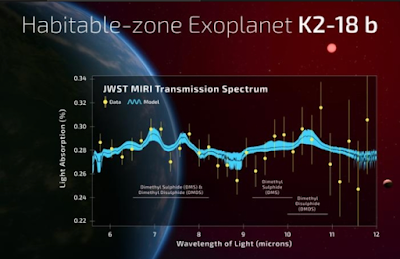The exoplanet K2-18 b is a water world or the Hycean planet. Distance to that planet is about 124 light years. The ocean planet is the so-called sub-Neptune. That exoplanet orbits the red dwarf K2-18 in 33 days. The earth is quite far from its host star. But it's locked. And the surface temperature is about -5-+8C. When we think about the red dwarf eruption. The oceans can give protection against that radiation pike.
The thing that makes the K-2-18b so interesting is that in its atmosphere are carbon dioxide, methane, and dimethyl sulfide. There is only a 0,3 percent possibility that those gasses form in some other ways than in biological processes.
"In 2019, the presence of water vapour in K2-18b's atmosphere was reported, drawing scientific attention to this system. In 2023, the JWST detected carbon dioxide and methane in the atmosphere of K2-18b. JWST’s data has been variously interpreted as indicating a water ocean planet with a hydrogen-rich atmosphere, and a gas-rich mini-Neptune. K2-18b has been studied as a potential habitable world that, temperature aside, more closely resembles an ice giant like Uranus or Neptune than Earth." (Wikipedia, K2-18b)
"The graph shows the observed transmission spectrum of the habitable zone exoplanet K2-18 b using the JWST MIRI spectrograph. (A. Smith, N. Madhusudhan/University of Cambridge)" (ScienceAlert, Strongest Evidence of Alien Life Yet Found 124 Light-Years Away)
"In 2025, the atmosphere of K2-18b was found to contain dimethyl sulfide (DMS), a chemical that could serve as a biomarker on exoplanets in quantities 20 times higher than on Earth. As the molecule is short-lived, the concentration is highly suggestive that DMS is being replenished.[4] Other scientists criticised this statement and pointed to lab experiments that can produce DMS without life." (Wikipedia, K2-18b).
The counter-criticism is that the DMS can be produced on purpose. But what is the possibility that the DMS forms in natural processes?
So, the k2-18b is the best candidate for lifeforms. Those lifeforms can be very primitive, like some algae in our oceans. In this text, the "primitive" means that the lifeforms can look like something like fish. But it will not be technically advanced.
We can think that K2-18b is like a very young Earth.
There can be oxygen in its oceans. Even if. There is no oxygen in the atmosphere.
The thing is that the K2-18b can have very complicated lifeforms like fish-type aliens. Those Hycean worlds are interesting. That means life itself can be quite a common thing in the universe. But the intelligent aliens might be rare things.
https://www.livescience.com/space/exoplanets/james-webb-telescope-could-find-signs-of-life-on-alien-hycean-ocean-worlds
https://www.sciencealert.com/strongest-evidence-of-alien-life-yet-found-124-light-years-away
https://en.wikipedia.org/wiki/Hycean_planet
https://en.wikipedia.org/wiki/K2-18b







